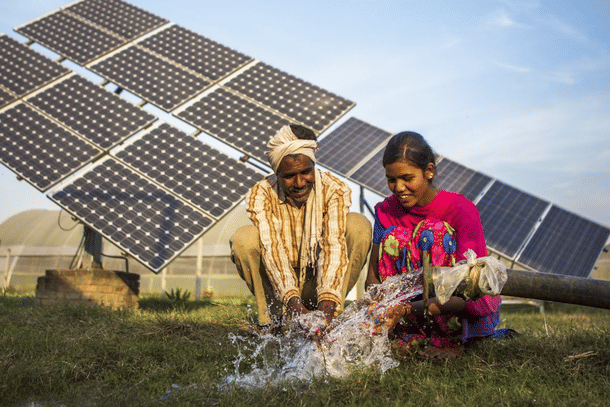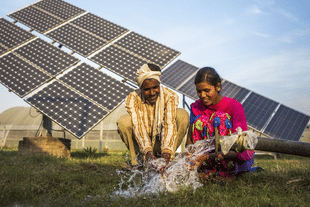Infrastructure
Tardy Progress In Installation Of Solar Pumps Under PM-KUSUM
Amit Mishra
Apr 10, 2022, 09:05 PM | Updated 09:08 PM IST
Save & read from anywhere!
Bookmark stories for easy access on any device or the Swarajya app.


Surging diesel fuel prices continue to burn a hole in the pocket of the already-stressed farming community. The government initiative aimed at de-dieselisation of the farm sector by providing solar water pumps under the PM-KUSUM scheme has been progressing at a tardy pace.
According to a written reply tabled in Lok Sabha on 24 March 2022, a total of 359,462 standalone solar pumps have been sanctioned under the scheme, of which only 82,408, or 23 per cent, pumps have been reported installed as on 28 February 2022.
PM-KUSUM Scheme
The Government of India approved the Pradhan Mantri Kisan Urja Suraksha evam Utthaan Mahabhiyan (PM-KUSUM) in 2019 with the objective of providing energy and water security to farmers, enhance their income, de-dieselise the farm sector, and reduce environmental pollution.
Under the scheme, a central financial assistance (CFA) is provided for installing standalone solar pumps. A CFA of 30 per cent of the benchmark cost or the price discovered through tender, whichever is lower, is provided. The state government gives a subsidy of 30 per cent and the remaining 40 per cent is provided by the farmer.
However, in the north eastern states, Sikkim, Jammu & Kashmir, Ladakh, Himachal Pradesh, Uttarakhand, Lakshadweep, and Andaman & Nicobar Islands, a CFA of 50 per cent of the benchmark cost or the price discovered through tender, whichever is lower, of the standalone solar pump is provided.
Allocation Criteria
The scheme is demand-driven and capacities are allocated to the states based on the demand received from them.
The selection of beneficiaries and implementation of the scheme is the responsibility of the state implementation agency. The implementing agencies submit proposals through an online portal to the Ministry of New and Renewable Energy (MNRE) for approval. Based on the overall target for the year and the demand received from implementation agencies, the ministry allocates the quantity of pumps to the implementation agencies in the states.
Tardy Progress
MNRE data shows that Maharashtra has been sanctioned the highest number of solar pumps, totaling 100,000, of which merely 1.48 per cent or 1,484 pumps have been installed.
Rajasthan is in the second place in the number of pumps allotted. The state has installed 24,937 pumps (38 per cent) of the total allocation of 65,000 pumps. Madhya Pradesh has installed 7,234 pumps (13 per cent) of the 57,000 pumps allocated under the scheme.
Arunachal Pradesh, Nagaland, Kerala, and Manipur have been allocated the least number of pumps under the scheme — 50, 50, 100, and 150 respectively.
Haryana occupies the top slot in installation, having installed 69 per cent pumps (25,534 out of 37,000 sanctioned pumps). Jharkhand is in the second spot, with a reported installation figure of 6,717 pumps out of 11,000 (61 per cent). Punjab comes a distant third, having installed 51 per cent pumps (6,192 out of 12,000 sanctioned pumps).
There are seven states that have not reported any installation, namely, Arunachal Pradesh, Assam, Chhattisgarh, Goa, Kerala, Nagaland, and Uttarakhand. The poor off-take of the scheme can be gauged from the fact that Chhattisgarh, which has zero reported installations, has been allotted 20,000 pumps under PM-KUSUM.
Why The Slow Progress?
The replacement of existing diesel pumps with solar pumps not only reduces irrigation costs by around Rs 50,000 per year (for 5HP pump) but also leads to reduction in pollution. It also helps in increasing the farmer’s income and living conditions, but securing them has not been an easy task for farmers.
Lack of awareness about the scheme, the role of middlemen, and 40 per cent financing from the farmer’s side are being cited as the reasons behind the sluggish progress of PM-KUSUM.
Most farmers are unaware of the scheme, and the void is filled by the middlemen who charge hefty amounts to help farmers get the benefit of the scheme. The problem is significant, considering the fact that the scheme mandates the implementation agency to carry out publicity of the scheme so as to increase awareness among potential beneficiaries.
Recent changes have been made in the scheme under which a dedicated amount has been set aside for nationwide information, education, and communication activities by the MNRE.
The scheme has a provision for banks financing the farmer’s contribution. Bank financing up to 30 per cent out of the 40 per cent share can be availed by the farmer, so that the farmer has to initially pay only 10 per cent of the total cost of the pump.
The state government can also provide more than 30 per cent subsidy, which further eases the financial burden on farmers.
To ease financing the farmers’ contribution, the scheme has been included under the priority sector lending guidelines issued by the Reserve Bank of India and a number of banks have introduced loan products for the PM-KUSUM scheme.
Further, installation of standalone solar pumps is also included under the Agriculture Infrastructure Fund (AIF) and farmers can avail the interest subvention facility of AIF.
MNRE has taken several steps to achieve the targets under the scheme. These include regular monitoring of the scheme, issue of clarifications and amendments to the scheme guidelines based on lessons learnt during implementation, organising workshops, and so on.
Amit Mishra is Staff Writer at Swarajya.





